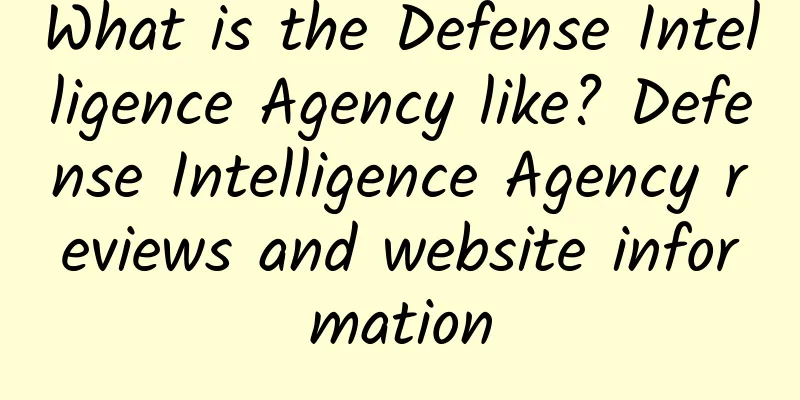What is the Defense Intelligence Agency like? Defense Intelligence Agency reviews and website information

|
What is the Defense Intelligence Agency? The Defense Intelligence Agency (DIA) is an American intelligence agency established in 1961. It is a foreign military intelligence agency under the U.S. Department of Defense. Website: www.dia.mil Defense Intelligence Agency: Demystifying one of the world's most secretive intelligence agenciesIn the field of international security, the Defense Intelligence Agency (DIA) is a very important name. As a military intelligence agency under the U.S. Department of Defense, DIA has been committed to providing key military intelligence support to the U.S. government and military since its establishment in 1961. This article will comprehensively analyze the historical background, functions and missions, organizational structure of this world's top intelligence agency, as well as the information and services provided by its official website - www.dia.mil. Historical evolution: from the Cold War to modern warfareThe establishment of DIA can be traced back to 1961, when during the Cold War, the US government realized that a unified military intelligence agency was needed to coordinate the intelligence work of the army, navy and air force and provide decision makers with more comprehensive and accurate military analysis. Against this background, President John F. Kennedy approved the establishment of DIA, making it the first inter-departmental agency in the United States dedicated to foreign military intelligence. Since its inception, DIA has been tasked with collecting, analyzing and distributing intelligence data related to national security. Over the past sixty years, DIA has undergone multiple reorganizations and modernizations to adapt to the changing international security environment. For example, during the Cold War, DIA's main focus was on the military dynamics of the Soviet Union and its allies; after the end of the Cold War, the agency gradually shifted its focus to areas such as counterterrorism, cybersecurity and emerging threats. Core functions: the behind-the-scenes force to ensure national securityThe core functions of DIA can be summarized as follows:
It is worth noting that DIA not only serves the security needs of the United States, but also actively participates in joint operations around the world. For example, DIA has played an indispensable role in the Iraq War, the Afghanistan War, and the fight against terrorism in recent years. Organizational structure: complex hierarchical systemDIA's organizational structure is complex and elaborate, divided into multiple departments and offices, each with clear division of responsibilities. The following is a brief introduction to the main components:
In addition, DIA also has a number of research centers and laboratories that focus on research on emerging technologies and future trends. This multi-level organizational structure enables DIA to flexibly respond to various challenges while maintaining efficient operations. Official website: www.dia.mil In-depth analysisFor the public, one of the best ways to learn about DIA is to visit its official website, www.dia.mil . Although as a highly confidential intelligence agency, DIA does not disclose all sensitive information on its website, its official website is still an important source of information, providing a lot of information about the agency's mission, history, news and career opportunities. Website layout and functionalityAfter entering www.dia.mil, users will find that it is a website with simple design and easy navigation. The homepage usually contains the following parts:
In addition to these basic sections, the DIA official website also has some special columns, such as "Historical Archives" and "Publications", for interested parties to gain in-depth understanding of the institution's past achievements and research results. Information Disclosure and Privacy ProtectionAlthough DIA is committed to transparency, it also takes strict measures when it comes to information security. All visitors to www.dia.mil are monitored when browsing to prevent unauthorized data disclosure. In addition, certain high-level or confidential content is only accessible to internal employees or certified partners. For those who want to join DIA, the "Career Development" page on the website is particularly important. Here are detailed recruitment criteria, job requirements, and how to submit an application. It is worth noting that due to the special nature of the work, candidates must pass extremely strict security screening before they can be hired. Future Outlook: Meeting New ChallengesAs the global security situation becomes increasingly complex, DIA faces unprecedented challenges and opportunities. On the one hand, traditional inter-state confrontations still exist, such as great power competition and regional conflicts; on the other hand, non-traditional security threats (such as terrorism, cyber attacks and climate change) are becoming increasingly prominent. In order to meet these challenges, DIA is accelerating its digital transformation and using cutting-edge technologies such as artificial intelligence, big data analysis and quantum computing to enhance its intelligence processing capabilities. At the same time, the agency is also strengthening cooperation with intelligence agencies of other countries to jointly build a closer global security network. Looking ahead, DIA will continue to play a key role in global security affairs. Whether it is tracking the development of enemy missiles or predicting the movements of transnational criminal groups, DIA will contribute to maintaining world peace and stability with its outstanding professional capabilities and strong technical support. ConclusionAs one of the world's top intelligence agencies, the DIA's influence goes far beyond the military field. From Soviet research during the Cold War to today's cybersecurity defense, the DIA has always been at the forefront of the times, safeguarding the security of the United States and the world. If you are interested in this mysterious and fascinating organization, you may visit its official website www.dia.mil to learn more about DIA's stories and achievements. Perhaps you will become a member of this great team and make your own contribution to defending human peace one day in the future. |
<<: How is the University of Lisbon? University of Lisbon reviews and website information
Recommend
The benefits of eating prunes
Prunes are a highly nutritious fruit. They come f...
The efficacy and function of the national flower peony
Everyone knows that peony is China's national...
The efficacy and function of yam and the medicinal value of yam
Yam is a common food in life. It can be used as a...
The efficacy and function of durian seeds
Have you ever eaten durian? It is a special fruit...
Steps for making Malantou mixed with dried tofu
Amaranthus is a common wild vegetable in our life...
Benefits of tomato mask
I think some girls will be more familiar with the...
The side effects of sour plum powder and the harm of sour plum powder
Sour plum powder is a convenient food. It is a re...
How is Alfred Dunhill? Alfred Dunhill reviews and website information
What is Alfred Dunhill? Alfred Dunhill (Dunhill fo...
How to eat asparagus How to eat asparagus
Asparagus is known as the king of vegetables and ...
What to do if you get burned? Tips for dealing with burns at home
In daily family life, burns are a common situatio...
How is the University of Iceland? University of Iceland reviews and website information
What is the website of the University of Iceland? ...
Pumpkin planting technology pictures
Do you want to know about pumpkin planting techni...
How to make delicious steamed egg cake? Ingredients and steps for steamed egg cake
Egg cake is golden in color and soft in taste, an...
What are the effects of drinking black plum water? What are the effects and benefits of drinking black plum water?
Black plum is a kind of health food obtained by d...
How to pickle dried carambola? Tutorial on pickling techniques for dried carambola
Star fruit contains a lot of fruit acid, fiber an...









